The Resource Management Division sets off-reservation hunting and trapping seasons/limits for enrolled band members, issues licenses and registers harvested animals in accordance with the 1854 Ceded Territory Conservation Code and the 1988 Agreement with the State of Minnesota. Beyond implementing and monitoring hunting and trapping activities, we participate in a variety of annual surveys and research projects to ensure that the resources upon which the treaty-reserved rights to hunt are based are being properly managed. Many of these activities are joint, inter-agency efforts. Cooperators include federal, state, county, tribal natural resource departments, conservation organizations, and private individuals.
Each year 1854 partners with the Minnesota Department of Natural Resources (DNR) and Fond du Lac Band to survey the moose population in the Arrowhead Region. The survey began in the early 1970’s to monitor the trends in moose population, whose range almost overlaps the 1854 Ceded Territory entirely. Flown with DNR helicopters, the survey is targeted to start the first working day in January if snow conditions are suitable (ie, snow provides a nice white backdrop to see moose).
In 2011, the survey crew began flying an additional nine habitat plots every year, in areas where management is focused on creating and maintaining moose habitat. They include areas burned in wildfires (Cavity, Ham, Pagami), areas being managed with prescribed fire, and areas with timber management focused on creating and maintaining suitable habitat. Hopefully surveying these habitat plots annually will shed some light on the most beneficial means of creating moose habitat and how quickly they respond to those efforts.
Minnesota Aerial Moose Survey StoryMap
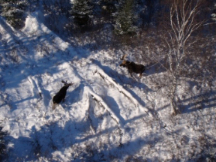
Since 2002, 1854 Treaty Authority has been collaborating with the Grand Portage Band, Bois Forte Band, Minnesota DNR, University of Minnesota, National Park Service, Minnesota Zoo, and other groups to conduct research and monitor the moose population to obtain baseline information on reproduction and survival rates, causes and rates of non-hunting mortality, habitat use and movement of individuals.
At first, moose research included fixing individuals with radio collars that allowed researchers to locate animals and determine if they were moving. Advances in technology have led to collaring moose with GPS collars that send locations and movement data through e-mail, allowing us to detect mortalities faster. Since 2002, multiple collaring events for various projects have resulted in about 100 moose wearing collars and providing the basis for study at any given time.
While project partners continue to focus on causes and rates of mortality, 1854 has turned their moose management efforts to assessing the preferences, availability, and quality of moose forage habitat…
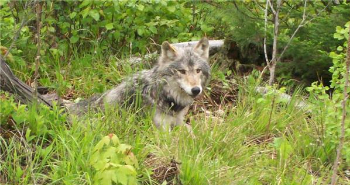 WOLF RESEARCH
WOLF RESEARCH
The gray wolf (Canis lupus) was officially listed as a federally endangered species in 1974 due to severe overharvest resulting from fur trapping, bounties, and livestock protection efforts. In 1978, wolves in Minnesota were reclassified as threatened, allowing state and federal authorities to manage for wolves praying on livestock. In the past three decades, Minnesota's keystone predator population has rebounded from an estimated low of 350 wolves to more than 3,000 wolves. Satisfying federal recovery criteria the gray wolves in the Western Great Lakes region were officially removed from the federal list of threatened and endangered species on March 12, 2007. At that point the management responsibility for Ma’iingan (wolf) returned to the states and tribes. Since 2007 there have been a series of delisting and relisting events for the gray wolf but as of today they remain a federally threatened species in Minnesota.
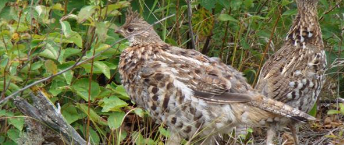 GROUSE SURVEYS
GROUSE SURVEYS
1854 Resource Management staff participate in a Minnesota DNR coordinated survey each spring to monitor ruffed grouse population trends. Drumming, performed by male ruffed grouse as a means to defend territory, is observed and counted to gather data on population density. Beginning in 2018, our staff have also participated in a new DNR-coordinated survey for spruce grouse, which involves counting fecal pellet piles along circular transects.
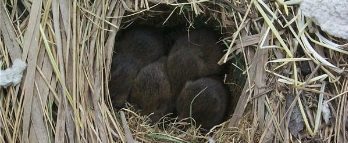 SMALL MAMMAL SURVEY
SMALL MAMMAL SURVEY
In autumn every year 1854 Treaty Authority coordinates a small mammal survey, to monitor trends in annual abundance of small animals like mice, voles, and shrews that are important in the diets of predators. There appears to be fairly good correlation between years of abundant small mammals in the woods and good numbers of juvenile fisher and pine marten in the fall trapping harvest.
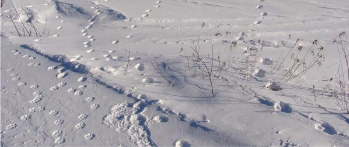 FURBEARER SURVEYS
FURBEARER SURVEYS
1854 participates in two Minnesota DNR surveys designed to track population trends in animals whose fur coats are valued. We implement a Scent Post Survey in early fall to identify and count the tracks of visiting furbearers to a baited area. The Winter Track Survey is conducted after a fresh snowfall to identify and count tracks along a roadway or trails, usually finding fisher, pine marten, red fox, wolf, and coyote.
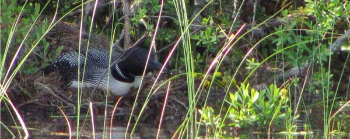 LOON SURVEYS
LOON SURVEYS
During a ten-day period in early July, program partners like 1854 and volunteers take to over 600 lakes throughout Minnesota to observe Maang (loon). Adult and juvenile loons are counted to analyze reproductive success and the data is reported to the DNR for a population analysis.
WATERFOWL SURVEYS
Resource Management Division staff have been participating in fall surveys of two lakes designated as waterfowl refuges in the 1854 Ceded Territory. These surveys help to determine if the refuges are benefitting waterfowl during the fall hunting season.
FISHER DEN BOX STUDY
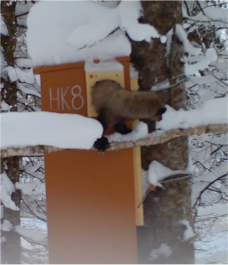 1854 Treaty Authority has been collaborating on a project led by researchers from the University of Minnesota Duluth – Natural Resources Research Institute, to determine if artificial den boxes might be beneficial for fishers. Fisher populations in Minnesota have declined over the last 20 years, and experts believe that den cavities large enough for these animals may be limited across the landscape. Because fishers are relatively large animals, a female fisher needs a large cavity (in a large tree) in which to give birth and raise her young (kits). Artificial den boxes were installed in the Superior National Forest in the fall of 2019. 1854 Treaty Authority biologists are helping to monitor these boxes to determine if they are being visited by fishers and/or other animals, and if they will be used by female fishers during the denning period (March-May).
1854 Treaty Authority has been collaborating on a project led by researchers from the University of Minnesota Duluth – Natural Resources Research Institute, to determine if artificial den boxes might be beneficial for fishers. Fisher populations in Minnesota have declined over the last 20 years, and experts believe that den cavities large enough for these animals may be limited across the landscape. Because fishers are relatively large animals, a female fisher needs a large cavity (in a large tree) in which to give birth and raise her young (kits). Artificial den boxes were installed in the Superior National Forest in the fall of 2019. 1854 Treaty Authority biologists are helping to monitor these boxes to determine if they are being visited by fishers and/or other animals, and if they will be used by female fishers during the denning period (March-May).


